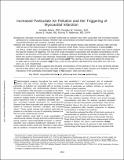| dc.contributor.author | Peters, Annette | |
| dc.contributor.author | Dockery, Douglas | |
| dc.contributor.author | Muller, James E. | |
| dc.contributor.author | Mittleman, Murray A. | |
| dc.date.accessioned | 2019-01-14T14:08:25Z | |
| dc.date.issued | 2001-06-12 | |
| dc.identifier.citation | Peters, Annette, Douglas W. Dockery, James E. Muller, and Murray A. Mittleman. 2001. “Increased Particulate Air Pollution and the Triggering of Myocardial Infarction.” Circulation 103 (23): 2810–15. https://doi.org/10.1161/01.cir.103.23.2810. | en_US |
| dc.identifier.issn | 0009-7322 | en_US |
| dc.identifier.issn | 1524-4539 | en_US |
| dc.identifier.uri | http://nrs.harvard.edu/urn-3:HUL.InstRepos:37989551 | * |
| dc.description.abstract | Background - Elevated concentrations of ambient particulate air pollution have been associated with increased hospital admissions for cardiovascular disease. Whether high concentrations of ambient particles can trigger the onset of acute myocardial infarction (MI), however, remains unknown.Methods and Results - We interviewed 772 patients with MI in the greater Boston area between January 1995 and May 1996 as part of the Determinants of Myocardial Infarction Onset Study. Hourly concentrations of particle mass (2.5 mum (PM2.5), carbon black, and gaseous air pollutants were measured. A case-crossover approach was used to analyze the data for evidence of triggering. The risk of MI onset increased in association with elevated concentrations of fine particles in the previous 2-hour period. In addition, a delayed response associated with 24-hour average exposure 1 day before the onset of symptoms was observed. Multivariate analyses considering both time windows jointly revealed an estimated odds ratio of 1.48 associated with an increase of 25 mug/m(3) PM2.5 during a 2-hour period before the onset and an odds ratio of 1.69 for an increase of 20 mug/m(3) PM2.5 in the 24-hour period 1 day before the onset (95% CIs 1.09, 2.02 and 1.13, 2.34, respectively).Conclusions - The present study suggests that elevated concentrations of fine particles in the air may transiently elevate the risk of MIs within a few hours and 1 day after exposure. Further studies in other locations are needed to clarify the importance of this potentially preventable trigger of MI. | en_US |
| dc.language.iso | en_US | en_US |
| dc.publisher | Ovid Technologies (Wolters Kluwer Health) | en_US |
| dc.relation.isversionof | http://circ.ahajournals.org/content/circulationaha/103/23/2810.full.pdf | en_US |
| dash.license | META_ONLY | |
| dc.subject | Physiology (medical) | en_US |
| dc.subject | Cardiology and Cardiovascular Medicine | en_US |
| dc.title | Increased Particulate Air Pollution and the Triggering of Myocardial Infarction | en_US |
| dc.type | Journal Article | en_US |
| dc.description.version | Version of Record | en_US |
| dc.relation.journal | Circulation | en_US |
| dash.depositing.author | Dockery, Douglas | |
| dc.date.available | 2019-01-14T14:08:25Z | |
| dash.workflow.comments | 1science | en_US |
| dc.identifier.doi | 10.1161/01.cir.103.23.2810 | |
| dc.source.journal | Circulation | |
| dash.source.volume | 103;23 | |
| dash.source.page | 2810-2815 | |
| dash.contributor.affiliated | Dockery, Douglas | |


